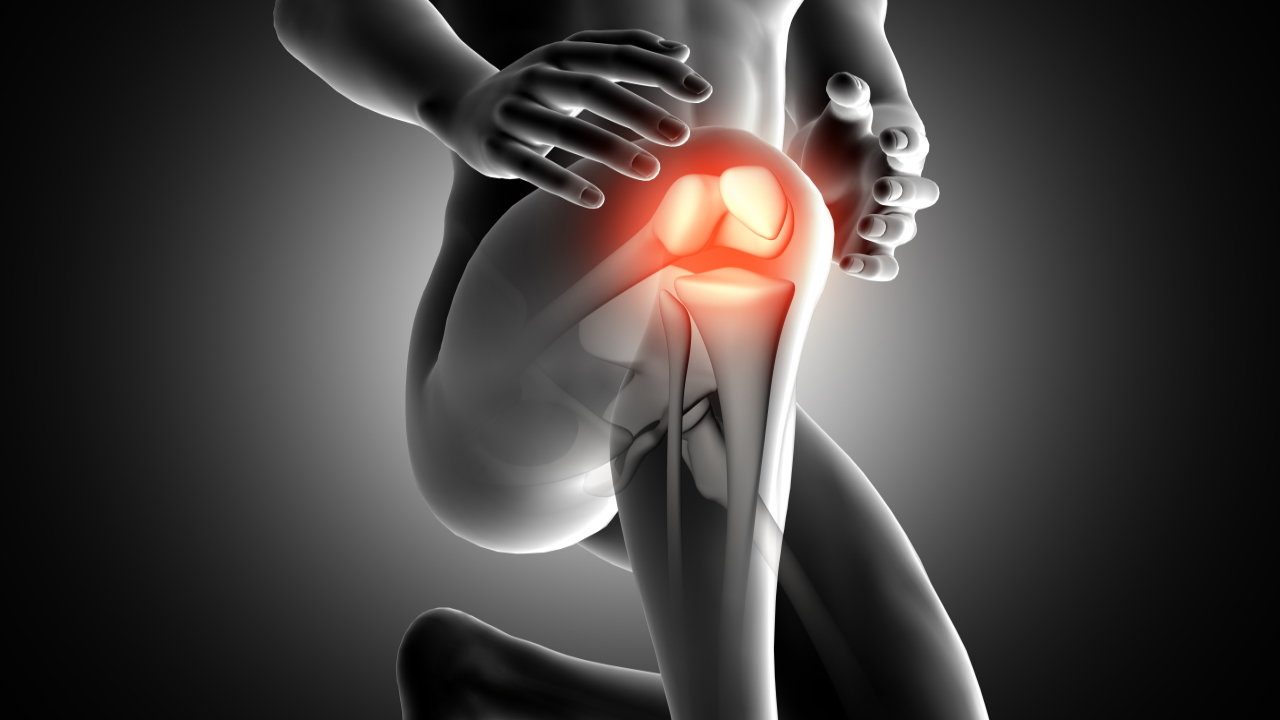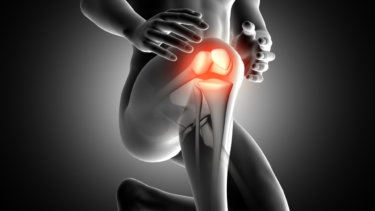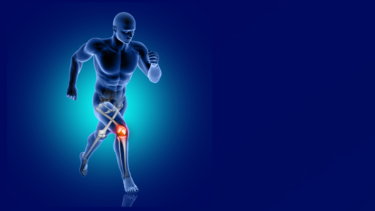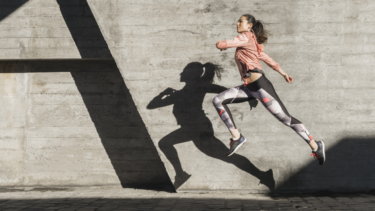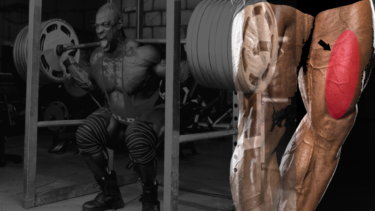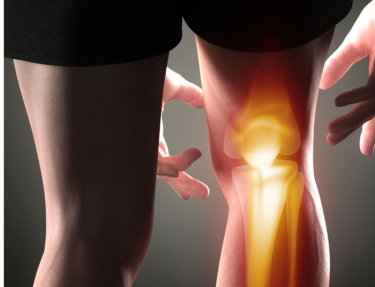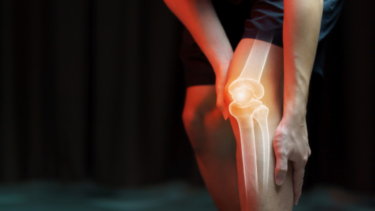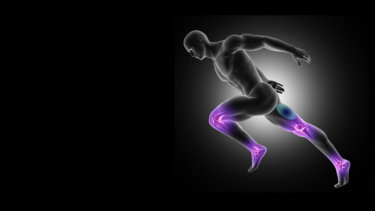前十字靭帯損傷の危険因子には以下のようなものがあります。
- 下肢関節のマルアライメント
- 下肢筋郡の機能低下
- 固有受容器の機能低下
- 性差
そてでは、これらの危険因子について解説していきます。
下肢関節のマルアライメント
股関節や足関節など下肢関節のマルアライメントにより、膝関節にも代償的な運動障害が引き起こされます。
なぜなら、ランニングやジャンプなどの動作により地面から足部に伝えられたエネルギーは、足関節から膝関節、股関節と上方に伝達されていくからです。
関節のマルアライメントや骨格のゆがみにより、各関節の運動が効率的に行われなくなり、その結果として局所的・機械的な負荷の増加が起こります。そして筋骨格神経系障害のリスクを高めることになります。
関節に過剰な負荷がかかることにより、関節の補強構造(特に靭帯や関節包)には顕微鏡レベルの損傷(微細外傷)が起こります。
それに伴い、機械受容器の機能低下が起こり関節の不安定性へと症状が進行していきます。
前十字靭帯損傷の危険因子には以下のようなものがあります。 下肢関節のマルアライメント 下肢筋郡の機能低下 固有受容器の機能低下 性差 本記事では、前十字靭帯傷害と下肢関節のマルアライメントの関係性について解[…]
下肢筋群の機能低下
前十字靭帯は脛骨の内旋と前方への変位を制限しています。
一方ハムストリングは、膝関節(脛骨)が外旋または内旋するのを制限(回旋安定性)し、同様に前方へ変位するのを制限しています。
ハムストリングは前十字靭帯の機能を補助している非常に重要な筋肉です。言い換えれば、ハムストリングの機能低下がある場合、前十字靭帯や膝関節関節包などの傷害リスクが高くなるということです。
Knapikらは、片側のハムストリングがもう一方のハムストリングに比べ15%以上筋力低下をおこしている女性アスリートは、下肢の傷害発生率が2.6倍高かったと報告しています。
また女性アスリートの20%から30%にこのような左右の筋力不均衡性が存在しています。
固有受容器の機能低下
膝関節の安定性は機械的安定性、さらに中枢神経系と関節との間の相互作用によって決まります。
中枢神経系が膝関節からの知覚情報を正確に認識できなければ、膝関節は不安定化します。
このようなコンディションで同じ動作を反復することで、関節周辺組織の微細外傷(マイクロトラウマ)が発生します。
従って、関節の正常な運動のためには、運動中に固有受容器が正常に機能していることが重要になります。
前十字靭帯の損傷後、症状が慢性化しているケースにおいて、固有受容器の機能低下が認められたとする研究があります。また前十字靭帯断裂後、静止位において姿勢を維持する能力に低下が見られています。
性差
女性アスリートの数が増えるに従い、女性のスポーツ障害が増加しています。
また男性アスリートに比べ、女性アスリートは前十字靭帯を損傷する割合が高いというデータもあります。
女性アスリートのスポーツ障害の増加要因は現段階では明確ではありませんが、靭帯や筋肉強度の性差、トレーニング歴、解剖学的差異、トレーニング技術などが要因として考えられます。
Obliphantらの研究によると、621人の男性アスリートのうち13人に前十字靭帯損傷が見られ(傷害発生率=2.1%)、それに対し女性アスリートは545人中26人に前十字靭帯損傷が見られた(傷害発生率=4.8%)と報告しています。これは、男性アスリートに比べ、女性アスリートの前十字靭帯損傷の発症率が高いことを裏付けています。
NCAA(National Collegiate Athletic Association)では、1982年以来スポーツ障害に関する資料を集積しており、前十字靭帯の傷害に関することについても報告しています。
それによると男性アスリートに比べ、女性アスリートの前十字靭帯損傷の割合が顕著に高いことが示されています。
女性アスリートと前十字靭帯損傷の危険因子には、主に以下の3項目があります。
- 体内ホルモンバランスの影響
- 解剖学的(構造的/骨格的)性差
- 筋肉/神経系機能の性差
女性アスリートの数が増えるに従い、女性のスポーツ障害が増加しています。 また男性アスリートに比べ、女性アスリートは前十字靭帯を損傷する割合が高いというデータもあります。 女性アスリートのスポーツ障害の増加要因は現段階では明確では[…]
関節運動学のおすすめ書籍
以下の2冊は関節運動学を理解するためにとてもよい教材となります。
カパンジーで関節運動学の基礎を学び、「筋骨格系のキネシオロジー 原著第3版」でさらに詳細を理解するのがおすすめです。
関節運動学の基礎を理解しているなら、最初から「筋骨格系のキネシオロジー 原著第3版」の一択でも大丈夫です。個人的には一冊目の「筋骨格系のキネシオロジー 原著第3版」が一押しの参考書です。
運動器障害における運動・動作分析の「準拠の枠組み」となるべく,900以上のカラーイラストや表とともに理路整然とした記述で説かれている世界的名著の原著第3版の完訳版
原著1st edから査読者をつとめてきたP.D.Andrew氏を新たな監訳者に迎え,すべての章を翻訳し直しており,より読みやすく,より的確で深い理解を得られる内容となった(アマゾンより抜粋)
豊富なイラストを用いた図解,わかりやすい解説によりまとめられた,世界的名著の原著第7版の完訳版.機能解剖学の名著として高い評価を得てきたシリーズ全3巻について,待望の完訳版を同時刊行!
骨・関節・筋の機能解剖学,生体力学,運動学について,簡明で理解しやすいイラストと明解な文章でわかりやすく解説した,機能解剖学の集大成!
「III 脊椎・体幹・頭部」では,「重心」「関節」に関する新項目が追加されたほか,各巻に「解剖学用語一覧」を掲載
リハビリテーション科医,整形外科医,理学療法士,作業療法士,柔道整復師など,臨床の現場で活躍する医療職に役立つのはもちろんのこと,機能解剖学・運動学のテキストとして養成校の学生にも活用いただける内容(アマゾンより抜粋)
関連動画
関連記事
膝窩筋の機能は膝関節の屈曲と内旋です。この筋肉には筋紡錘が密に存在しており、脛骨が過剰に外旋するのを防ぎ、膝関節を安定化する役割を持っています。
解剖学(起始・停止・作用・神経支配) 起始;大腿骨外側上顆、腓骨頭、外側半月後角 停止;脛骨の後面(ヒラメ筋線の上側) 作用;膝関節の屈曲、内旋 神経支配;脛骨神経、L4-S1 膝窩筋の起始は、大腿骨外側顆、腓骨頭、外[…]
内側広筋の一部にはVMOと呼ばれる部位があり、膝蓋骨の運動に多大な影響を与えます。本記事では内側広筋の解剖学と関連症状について解説してあります。
内側広筋は大腿四頭筋の一部です。 大腿四頭筋には大腿直筋、外側広筋、内側広筋、中間広筋の4つの筋肉があります。 内側広筋の一部にはVMOと呼ばれる部位があり、膝蓋骨の運動に多大な影響を与えます。 本記事では内側広筋の解剖学[…]
膝蓋骨に運動障害がある場合、関節面(関節軟骨)への負荷(圧迫)にも変化が生じます。その結果、局所的に強い負荷が加わる領域が現れ、変形性関節症や離断性骨軟骨炎へと発展することがあります。
膝蓋骨の運動 膝関節を屈曲させた時、膝蓋骨は下方へ滑り運動が生じます。一方、伸展では上方に滑り運動が起こります。 しかし、膝関節の屈曲・伸展に伴う膝蓋骨の動きはもう少し複雑です(この件については後ほど解説します)。臨床ではこの複雑な[…]
大腿脛骨関節では、主に屈曲と伸展の運動が生じます。また、屈曲・伸展に伴い、回旋(内旋・外旋)と内反・外反(内転・外転)の副次的運動(カップリングモーション)も生じています。
膝関節は大腿骨、脛骨、膝蓋骨の3つの骨によって構成されており、大腿脛骨関節と膝蓋大腿関節の2つの関節があります。 大腿脛骨関節は大腿骨遠位部と脛骨近位部によって、また膝蓋大腿関節は膝蓋骨後面と大腿骨遠位部前面によって形成されています。[…]
参考文献
- Beckett ME, Massie DL, Bowers KD, Stoll DA: Incidence of hyperpronation in the ACL injured knee: a clinical perspective.. J Athl Train 27:58-62,1992
- Huegel M, Meister K, Rolle G, Indelicato PA, Hartzel J: The influence of lower extremity alignment in the female population on the incidence of noncontact ACL tears.. 23rd Annual Meeting of the American Orthopaedic Society for Sports Medicine,1997
- Loudon JK, Jenkins W, Loudon KL: The relationship between static posture and ACL injury in female athletes.. J Orthop Sports Phys Ther 24:91-97,1996
- Mueller MJ, Host JV, Norton BJ: Navicular drop as a composite measure of excessive pronation.. J Am Podiatr Med Assoc 83:198-202,1993
- Woodford-Rodgers B, Cyphert L, Denegar CR: Risk factors for anterior cruciate ligament injury in high school and college athletes.. J Athl Train 29:343-346,1994
- Kalenak A, Morehouse CA: Knee stability and knee ligament injuries.. JAMA 234:1143-1145,1975
- Knapik JJ, Bauman CL, Jones BH, Harris JM, Vaughan L: Preseason strength and flexibility imbalances associated with athletic injuries in female collegiate athletes.. Am J Sports Med 1:76-81,1991
- Moore JR, Wade G: Prevention of anterior cruciate ligament injuries.. Natl Strength Cond Assoc J 11:35-40,1989
- More RC, Karras BT, Neiman R, Fritschy D, Woo SL, Daniel DM: Hamstrings-an anterior cruciate ligament protagonist: an in vitro study.. Am J Sports Med 21:231-237,1993
- Moul JL: Differences in selected predictors of anterior cruciate ligament tears between male and female NCAA Division I collegiate basketball players.. J Athl Train 33:118-121,1998
- Renstrom PS, Arms W, Stanwyck R, Johnson RJ, Pope MH: Strain within the anterior cruciate ligament during hamstring and quadriceps activity.. Am J Sports Med 14:83-87,1986
- Baratta R, Solomonow M, Zhou BH, Letson D, Chuinard R, D’Ambrosia R: Muscular coactivation: the role of antagonist musculature in maintaining knee stability.. Am J Sports Med 16:113-122,1988
- Huston L, Wojtys EM: Neuromuscular performance characteristics in elite female athletes.. Am J Sports Med 24:427-436,1996
- O’Conner JJ: Can muscle co-contraction protect knee ligaments after injury or repair?. J Bone Joint Surg Br 75:41-48,1983
- Palmitier RA, An KN, Scott SG, Chao EY: Kinetic chain exercise in rehabilitation.. Sports Med 11:402-413,1991
- Sinkjaer T, Arendt-Nielsen L: Knee stability and muscle coordination in patients with anterior cruciate ligament injuries: an electromyographic approach.. J Electromyogr Kinesiol 1:209 -217 J Electromyogr Kinesiol 1:209-217,1991
- Solomonow M, Baratta R, Zhou BH: The synergistic action of the anterior cruciate ligament and thigh muscles in maintaining joint stability.. Am J Sports Med 15:207-213,1987
- Wojtys EM, Huston LJ: Neuromuscular performance in normal and anterior cruciate ligament-deficient lower extremities.. Am J Sports Med 22:89-104,1994
- Wojtys EM, Huston LJ, Taylor PD: Neuromuscular adaptations in isokinetic, isotonic and agility training programs.. Am J Sports Med 24:187-192,1996
- Wojtys EM, Wylie BB, Huston LJ: The effects of muscle fatigue on neuromuscular function and anterior tibial translation in healthy knees.. Am J Sports Med 24:615-621,1996
- Sahrmann SA: Diagnosis and treatment of muscle imbalances associated with musculoskeletal pain.. ,1987
- Fish DJ: Ligament integrity protects against stress and strain.. Biomechanics 5(3):49-53,1998
- Nigg BM: Biomechanics, load analysis and sports injuries in the lower extremities.. Sports Med 2:367-379,1985
- Ireland ML, Gaudette M, Crook S: ACL injuries in the female athlete.. J Sport Rehabil 6:97-110,1997
- Fu FH, Stone DA: Sports Injuries: Mechanisms, Prevention, Treatment.. Philadelphia, PA: Williams & Wilkins 153-187.,1994
- Gould N: Evaluation of hyperpronation and pes planus in adults.. Clin Orthop 181:37-45,1983
- Mann RA: Biomechanics of the foot and ankle. In: Mann RA, Coughlin MJ, eds. Surgery of the Foot and Ankle. 6th ed. St. Louis, MO. Mosby 19-23,1993
- Vogelbach WD, Combs LC: A biomechanical approach to the management of chronic lower extremity pathologies as they relate to excessive pronation.. Athl Train, JNATA 22:6-16,1987
- Carl A, Ross S, Evanski P, Waugh T: Hypermobility in hallux valgus.. Foot Ankle 8:264-270,1988
- Staheli LT: Torsional deformity.. Pediatr Clin North Am 24:799-812,1977
- Staheli LT, Corbett BS, Craig W, Howard K: Lower-extremity rotational problems in children: normal values to guide management.. J Bone Joint Surg Am 67:39-47,1985
- Welsh RP, Hutton C: Patellofemoral arthralgia, patellar instability, and chondromalacia patella.. Philadelphia, PA: BC Decker, Inc 262-266,1990
- Gross ML, Nasser S, Finerman GAM: Hip and pelvis. In: DeLee JC, Drez D, eds. Orthopaedic Sports Medicine. Vol 2. Philadelphia, PA. WB Saunders Co 1065,1994
- Shambaugh PJ, Klein A, Herbert JH: Structural measures as predictors of injury in basketball players.. Med Sci Sports Exerc 23:522-527,1990
- Barrett DS: Proprioception and function after anterior cruciate reconstruction.. J Bone Joint Surg 73-B:833-837,1991
- Barrack RL, Skinner HB, Buckley SL: Proprioception in the anterior cruciate deficient knee.. Am J Sports Med 17:1-6,1989
- Johansson H, Sjolander P, Sojka P: Activity in receptor afferents from the anterior cruciate ligament evokes reflex effects on fusimotor neurones.. Neurosci Res (NY) 8:54-59,1990
- Arendt EA: Orthopaedic issues for active and athletic women.. Clin Sports Med 13:483?503,1994
- Slauterbeck J: Epidemiology and comparison of ACL injuries in male and female collegiate soccer athletes.. Orthop Trans 19:285,1995
- Arendt EA, Agel J, Dick RW: Anterior cruciate ligament injury patterns among collegiate men and women.. J Athl Train 34:86?92,1999
- Cox JS, Lenz HW: Women midshipmen in sports.. Am J Sports Med 12(3):241-243,1984
- Ned AH, Patricia AE, Charls LB, James AW: Hormonal Changes Throughout the Menstrual Cycle and Increased Anterior Cruciate Ligament Laxity in Females.. J Athl Train 34(2):144-149,1999
- Oliphant JG, Drawbert JP: Gender Differences in Anterior Cruciate Ligament Injury Rates in Wisconsin Intercollegiate Basketball.. J Athl train 31(3):245-247,1996
- Arendt E, Dick R: Knee injury patterns among men and women in collegiate basketball and soccer: NCAA data and review of literature.. Am J Sports Med 23(6):694-701,1995
- Hama H, Yamamuro T, Takeda T: Experimental studies on connective tissue of the capsular ligament: influences of aging and sex hormones. Acta Orthop Scand 47:473-479,1976
- Lloyd T, Triantafyllou SJ, Baker ER: Women athletes with menstrual irregularity have increased musculoskeletal injuries. Med Sci Sports Exerc 18:374-378,1986
- Lui SH, Al-Shaikh RA, Panossian V, Finerman GAM, Lane JM: Estrogen affects the cellular metabolism of the anterior cruciate ligament: a potential explanation for female athletic injury. Am J Sports Med 25:704-709.,1997
- Wojtys EM, Huston LJ, Lindenfeld TN, Hewett TE, Greenfield LVH: Association between the menstrual cycle and anterior cruciate ligament injuries in female athletes.. Am J Sports Med 26:614-619,1998
- Hutchinson MR, Ireland ML: Knee injuries in female athletes.. Sports Med 19:288-302,1995
- Liu SH, Al-Shaikh RA, Panossian V, Finerman GA, Lane JM: Estrogen affects the cellular metabolism of the anterior cruciate ligament: a potential explanation for female athletic injury.. Am J Sports Med 25:704-709,1997
- Hakkinen K: Force production characteristics of leg extensor, trunk flexor and extensor muscles in male and female basketball players.. J Sports Med Phys Fitness 31:325-331,1991
- Komi PV, Karlsson J: Physical performance, skeletal muscle enzyme activities, and fibre types in monozygous and dizygous twins of both sexes.. Acta Physiol Scand 462(suppl): 1-28,1979
- Bell DG, Jacobs I: Electro-mechanical response times and rate of force development in males and females.. Med Sci Sports Exerc 18:31-36,1986
- Viitasalo JT, Komi PV: Interrelationships between electromyographic, mechanical, muscle structure and reflex time measurements in man.. Acta Physiol Scand 111 :97-103,1981
- Winter EM, Brookes FB: Electromechanical response times and muscle elasticity in men and women.. Eur J Appl Physiol 63:124-128,1991
